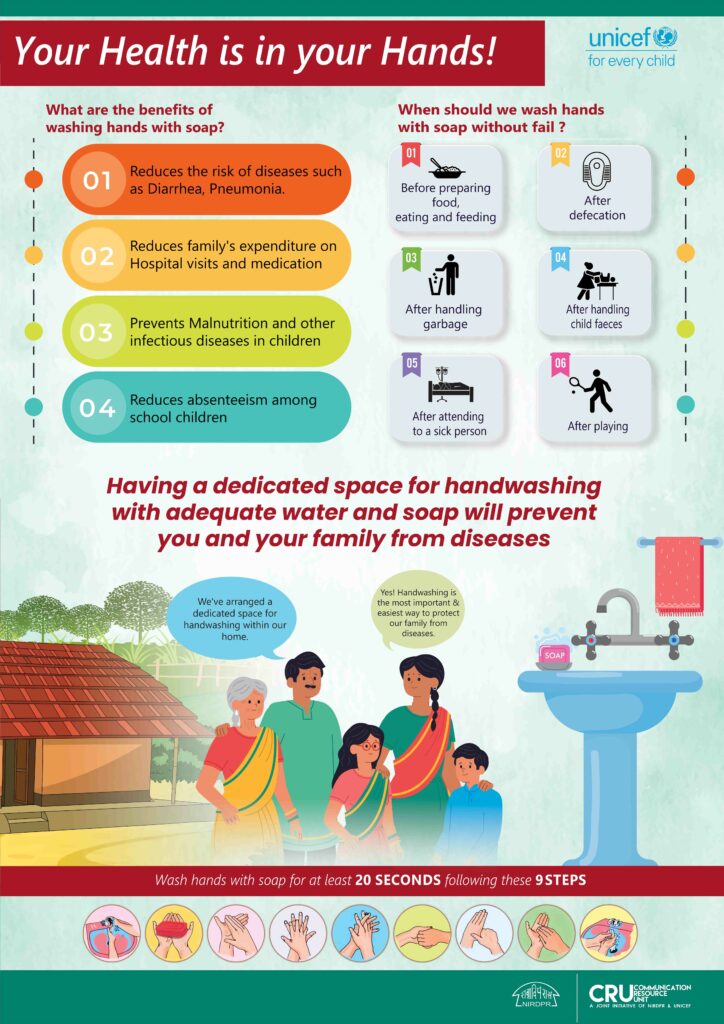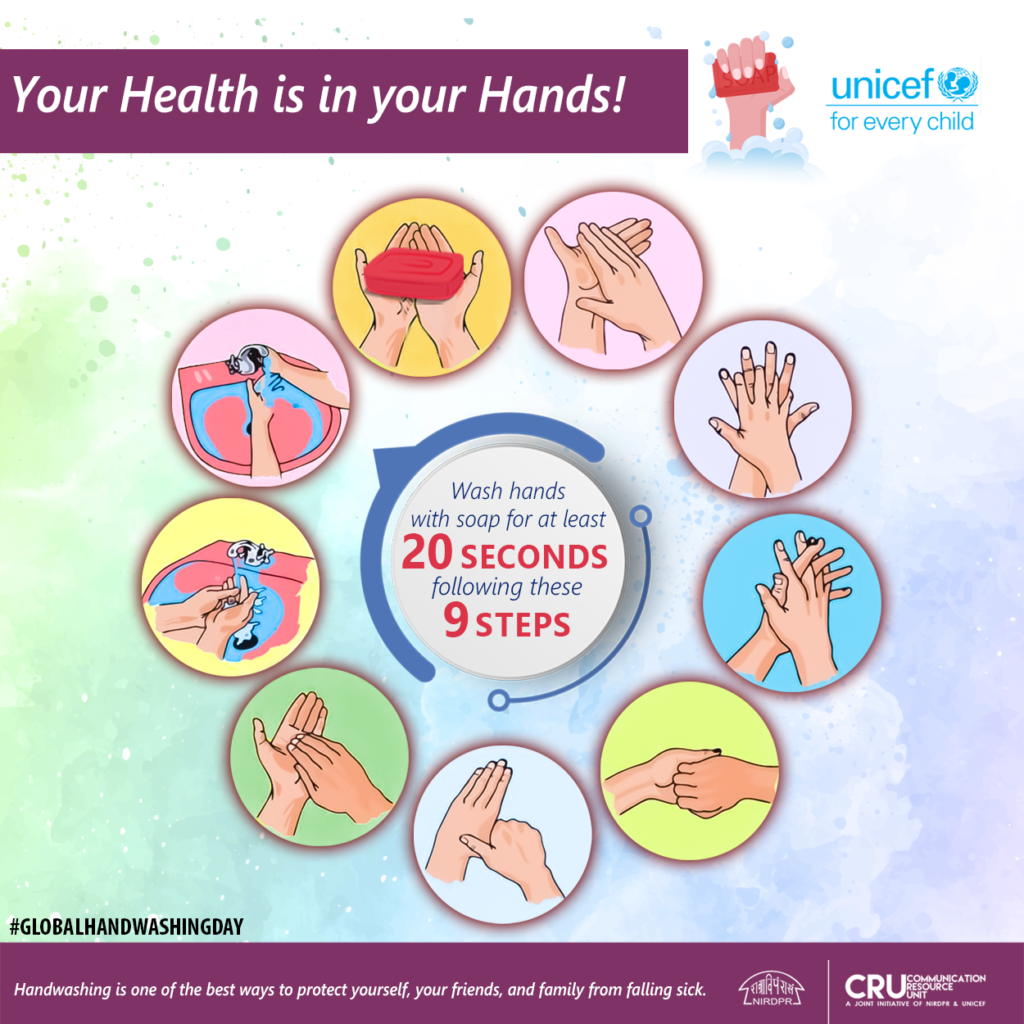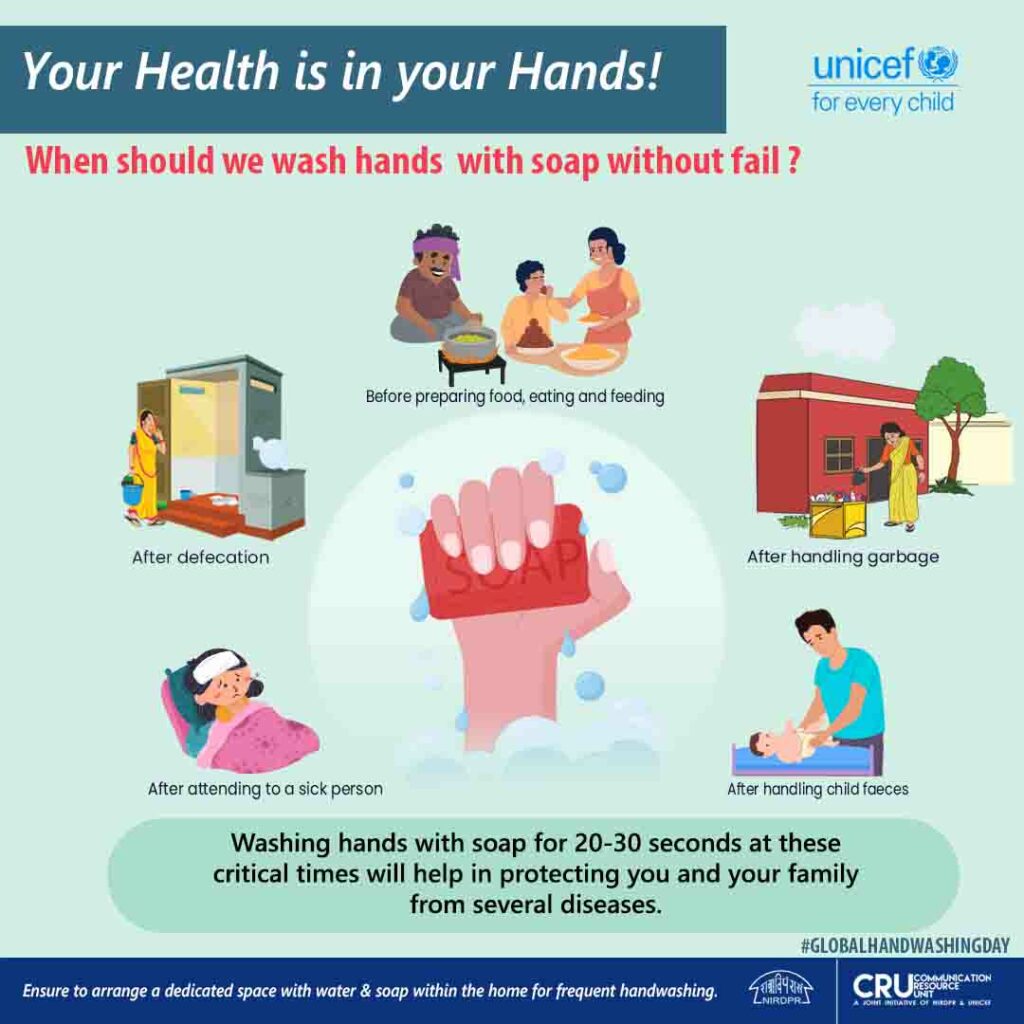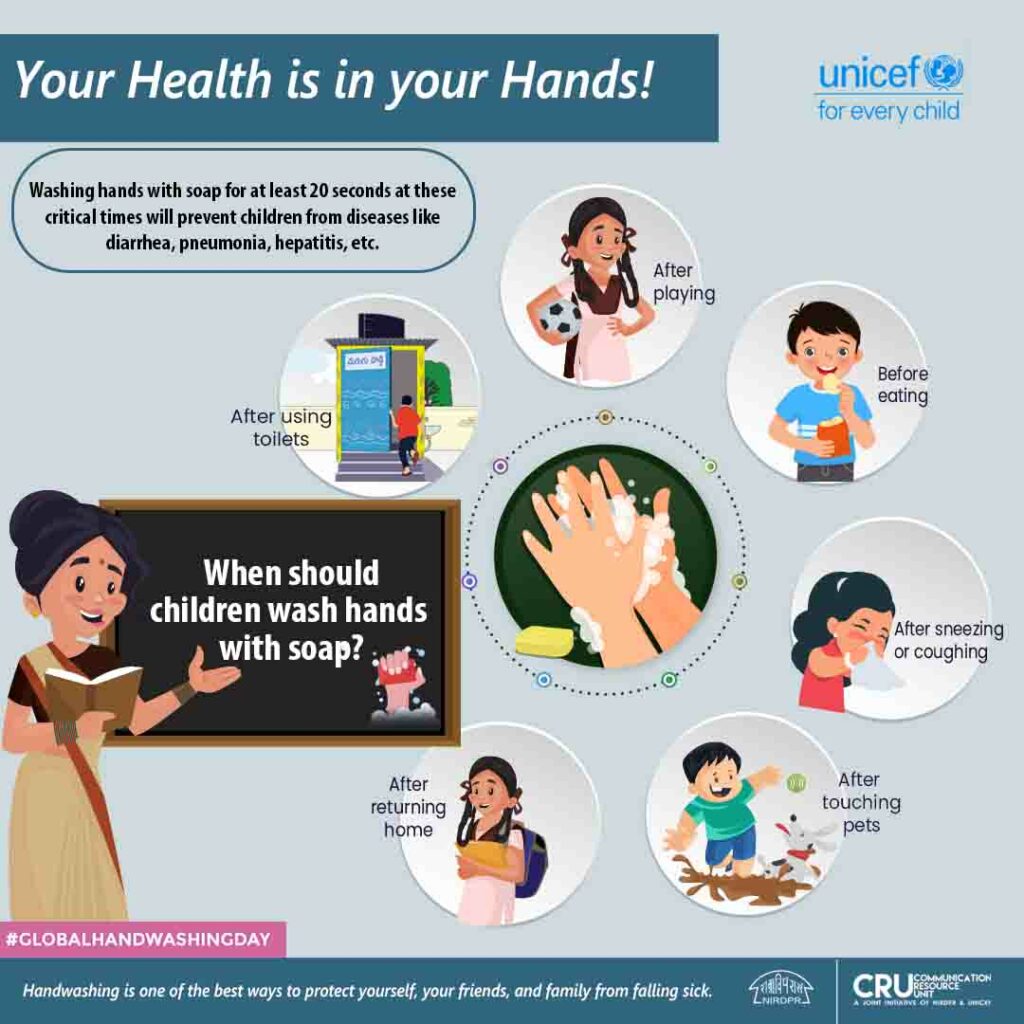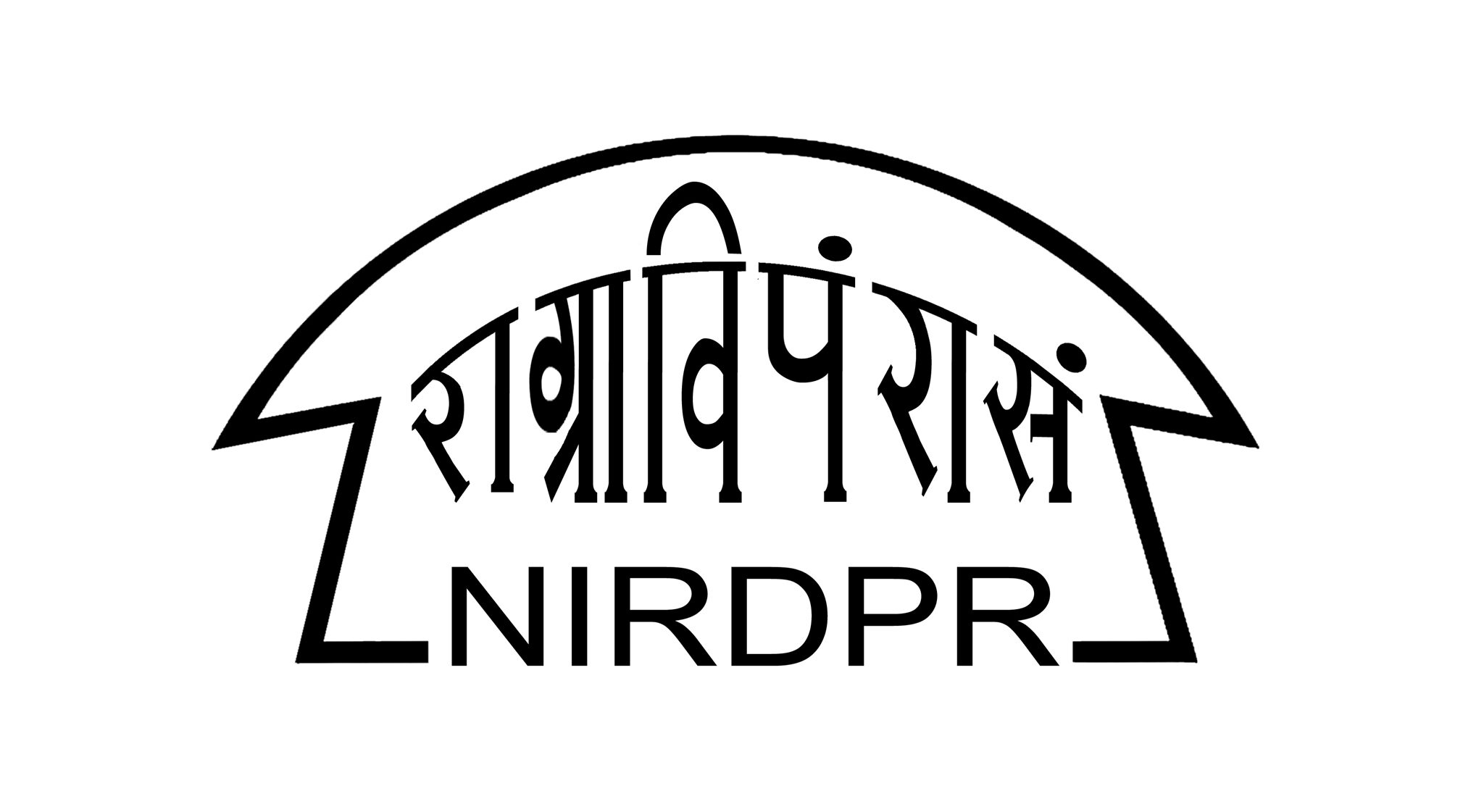
CONTENTS:
COVER STORY: Saansad Adarsh Gram Yojana: A Model of Convergence-Based Development
NIRDPR Inks Pact with National Health Systems Resource Centre
NIRDPR Celebrates Mahatma Gandhi’s 153rd Birth Anniversary
ToT Programme on TMS and SECURE for Estimation of MGNREGS Works
Training Methods and Techniques for Faculty of Rural Development Institutes
Orientation Workshop on Financial Inclusion for Bankers at Uttarakhand SRLM
NIRDPR Wellness Committee Organises Blood Donation Camp
NIRDPR Organises Hindi Day Celebrations
ToT Programme on Value Chain & Business Development Plan-Level-II under Non-Farm Livelihoods
Communication Research Unit, NIRDPR Releases Posters on Hand Wash Campaign
COVER STORY:
Saansad Adarsh Gram Yojana: A Model of Convergence-Based Development
India is the second most populous country in the world and is known as a country of rural areas, as more than 60 per cent of its population still lives in 6,49,481 villages. Therefore, it is believed that the soul of India lives in its villages. The governments – both at the Centre and States – have been implementing schemes and programmes to develop villages, and their impact can be seen on rural development indicators over a period of time. However, desirable changes and impacts of these schemes and programmes on the holistic development of rural communities could not be achieved due to several factors. This article discusses a few most common observations in this regard.
A common observation made in several literature and research reports is that these schemes and programmes were implemented in rural areas with a top-to-bottom approach. As a result, there was always a mismatch between the demand of rural communities and supply of schemes and programmes.
The second observation is that since the inception of rural development schemes and programmes to date, almost all of them focused more on creation of infrastructure or basic amenities in villages. In that process, socio-cultural and human aspects of development were completely missed out, which resulted in poor socio-economic and human development status of the rural population.
The third observation is that since development of human resources was not the focus of many rural development schemes, villages could not attain self-reliance or self-sufficiency for sustainable development; rather villages were made to rely on grants and subsidies. Therefore, the demand for schemes attracting huge budget allocation is high among villagers, and hence more than 2000 Centrally or State sponsored schemes, which are being implemented currently at the Gram Panchayat level, entail huge budget. It is also a fact that the actions requiring budgetary provisions also need a robust MIS and accountability system for proper monitoring and regulation of the expenditure made under the allotted budget. Although monitoring systems are put in place to ensure the proper utilisation of budget for the effective implementation of schemes, irregularities in financial transactions, corruption, and poor monitoring systems are being reported as major barriers that obstructs the benefits from reaching the beneficiaries. Thus, appropriate management and utilisation of budget of a scheme has always been a challenge for the governments.
To continue further, the coordination among the existing schemes and programmes having the common goal of providing benefits to the rural people is barely visible at all levels of programme implementers. On the contrary, it has been strongly recommended by rural development professionals, practitioners and policymakers that the convergence between the schemes and programmes of different departments is need of the hour and key to rural development.
In view of the above backdrop and inspired by Mahatma Gandhi’s vision of an ideal village, a unique scheme called ‘Saansad Adarsh Gram Yojana (SAGY)’ was launched by Shri Narendra Modi, Honorable Prime Minister of India on 11th October, 2014 with the objectives of creating Adarsh Gram Panchayats as the nucleus of health, cleanliness, greenery and cordiality within the community under the overall supervision of Ministry of Rural Development, Government of India. This scheme is unique in the following ways and tries to address the major causes of holistic rural development:
- This scheme aims to empower the villagers to make choices and provide them with opportunities to exercise their choices, i.e., the people of the village will be empowered to decide what is needed to make it an Aadarsh village. In other words, this scheme truly believes in the bottom-to-top approach to development. Therefore, unlike other schemes, SAGY does not look at the beneficiaries as a receiver and the government as a doer, but rather as the key persons leading the development process of their community.
- This scheme primarily focuses on the creation of non-infrastructure assets in the Gram Panchayats, i.e., building up socio-cultural and human development, thereby enabling the people of Gram Panchayat as ‘self-reliant’ rather than ‘dependent on grants/subsidies.’
- Another uniqueness of this scheme is the absence of any budget allocation for carrying out developmental activities in the identified Gram Panchayats. Since there is no budget provision, it reduces even the minimal chance of any misappropriation of funds.
- However, this scheme ensures holistic development of the identified Gram Panchayats by unleashing people’s power and convergence of more than 2000 Central sectors/Centrally sponsored/State Govt. schemes. SAGY is the first-of-its-kind scheme, which is solely based on the convergence model of development.
Role of Honorable Parliamentarians (Saansad):
For the first time in the history of rural development, Members of Parliament have been advised to identify a Gram Panchayat from their constituency and develop it as Adarsh Gram Panchayat using convergence approach. This scheme provides an opportunity to create model villages by leveraging the leadership, capacity, commitment and energy of the Members of Parliament. In addition, the role of MPs is crucial in mobilising the community, propagating the values of SAGY among the people, enabling of conducive environment in the identified GPs to initiate the developmental activities and also facilitating villagers to prepare holistic development plans for their villages. The MPs are expected to nurture these ‘Adarsh Gram’ to serve as demonstration villages for the surrounding villages to learn and replicate these efforts.
Goal of the Scheme
Primarily, the goal of the scheme was to develop three Adarsh Grams by March 2019, of which one was to be achieved by 2016. Thereafter, five such Adarsh Grams (one per year) will be selected and developed as Adarsh GP by 2024.
Objectives of the Scheme
In the process of making Adarsh village, certain objectives have to be achieved, such as (i) triggering the process of holistic development in village, (2) improving the quality of life in the village, (iii) generating the models of local level development which can motivate and inspire neighbouring Gram Panchayats for replication, and (iv) nurturing the identified Adarsh Grams as schools of local development to train other Gram Panchayats.
Activities in Aadarsh Gram
It envisages an integrated development of the identified Gram Panchayat across eight development sectors, namely personal, human, economic, social, environmental, basic amenities, social security and good governance. However, SAGY does not confine the boundary of activities that can be taken up for the development of the villages. SAGY seeks to provide physical infrastructure and access to basic amenities; but the focus is more on non-infrastructural activities such as personal development, social capital, economic development, community spirit, etc.
Mechanism/Framework for Convergence
Keeping in view the uniqueness of this programme in demonstrating Adarsh Gram, this scheme intends to achieve the same by implementing existing government schemes and programmes through ‘convergence’ mode only. The Ministry of Rural Development, Govt. of India has taken the following steps to facilitate planning and execution of projects/activities for the effective implementation of the scheme through convergence and coordination:
- Secretaries of the relevant Ministries/Departments of the Central Government have been requested by the Ministry of Rural Development to make suitable changes, wherever appropriate, in the guidelines of their respective Central Sector and Centrally Sponsored Schemes/Programmes to attach priority to the Gram Panchayats identified under SAGY. To this effect, various Departments of the Government of India have already issued advisories in respect of 22 schemes to accord priority to SAGY.
- In addition, MoRD has also brought out a document called SAMANVAYA, which is a compilation of 223 central sectors & centrally sponsored schemes and 1924 State schemes for convergence under SAGY. The updated version of this document is also available on the SAGY website (saanjhi.gov.in). The purpose of this document is to provide necessary guidance to the officials/functionaries concerned to make use of the existing schemes and its resources for the activities to be undertaken.
- Another document is SAHYOG, which is also a compilation of the existing social security schemes collated from respective ministries.
- Similarly, existing good practices in rural development are also collated in one place so that it can be replicated/adopted in SAGY Gram Panchayats. Also, a compendium of good practices under SAGY GPs is also an achievement to share among other SAGY GPs. These documents can be made accessible on the SAGY website.
- In addition to the above, a well-structured capacity building training programme has been designed by NIRDPR, Hyderabad for the Charge Officers and other stakeholders who are directly involved with the implementation of SAGY at the village level. NIRDPR has been conducting a series of capacity building programmes on regular basis since its inception.
- Two national-level committees (one is headed by the Minister of Rural Development, and the other is headed by the Secretary, Rural Development, Govt. of India), State Level Empowered Committee headed by the Chief Secretary of the State, and District Level Committee are in force to monitor the progress of SAGY and provide required inputs for effective convergence.
- Regular visits of satff from Project Management Unit of SAGY division, MoRD to different States/UTs also provide feedback for the effective monitoring and convergence of the existing schemes and programmes.
Situational Analysis of SAGY
As of now, 3,027 Gram Panchayats have been identified by Members of the Parliament (see the graph below). The year 2019 observed a sharp decline in the identification of GPs – probably the MPs could not devote adequate time due to General Election scheduled during the period. The year 2020-22 also witnessed a sharp decline in the identification of GPs, mainly due to the unprecedented incidence of COVID-19 pandemic. Identification of GPs for the years 2022-23 and 2022-24 is in progress. Nearly 50 per cent of Gram Panchayats have been identified as SAGY GPs by MPs as against the target. States/UTs such as Andaman Nicobar & islands, Chhattisgarh, Gujarat, Haryana, Jammu and Kashmir, Manipur, Meghalaya, Mizoram, Sikkim, and Tamil Nadu have performed better in terms of identification of SAGY GPs compared to others. These States/UTs have already identified more than 70 per cent of the SAGY GPs.
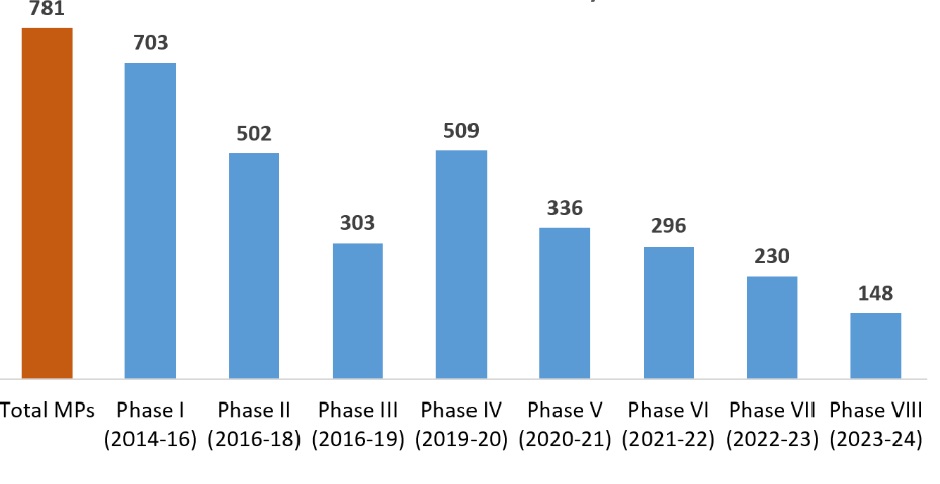
As mentioned earlier, the scheme intends to carry out developmental activities in identified GPs through convergence. The following table (Table 1) reveals that as on date, 50 per cent of activities proposed in the village development plan (VDP) have been completed using the convergence approach of development, while another 3 per cent of works are in progress. The number shown in the table are dynamic in nature and keep changing.
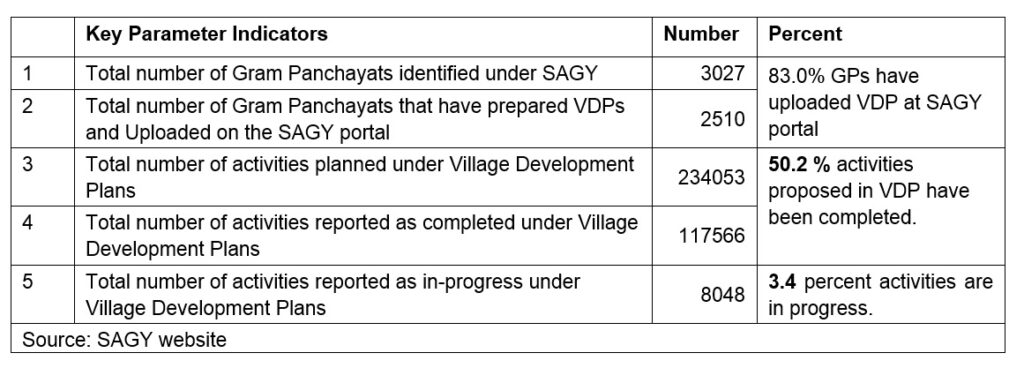

As SAGY believes that socio-cultural and human development is the key to the sustainable and holistic development of Gram Panchayats, it proposes to focus more on the non-infrastructural development of the identified GPs than infrastructural development, and the graph presented here justifies the same. Graph 2 depicts that while 81 per cent of total developmental activities carried out in identified SAGY GPs were non-infrastructural in nature, such as economic development, human development, social development, environmental development, personal development, governance, and social security, only 19 per cent of activities were related to infrastructural development.
In addition to factual information, qualitative information in terms of the adequate number of success stories/videos has also been shared by majority of the States/UTs, which are uploaded on the SAGY website. Following are a few select pictures of SAGY GPs that depict remarkable developmental activities.


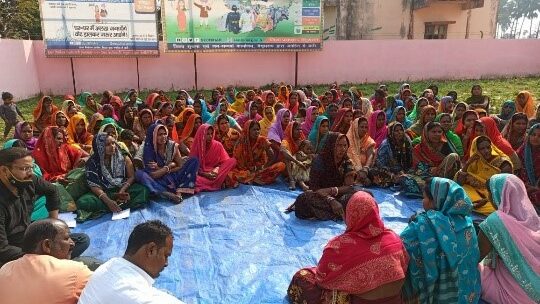

To sum up
This scheme is unique in the sense that there is no additional fund allocation for carrying out developmental activities at village level in order to make the village as Adarsh Gram Panchayat as envisioned by people of Gram Panchayat. However, it is proved in the SAGY project that without allocation of fund also the development activities can be implemented by using the resources already available with existing schemes and programmes of different departments of ministries through convergence and effective coordination.
It is evident that more than one lakh seventeen thousand of activities as envisaged by people of SAGY panchayats have already been completed in SAGY GPs which is to be highlighted.
Although there is scope for further improvement in the implementation of SAGY, but even then it has provided the mechanism/framework for the policy-makers and implementing agencies to the effect that development can also be achieved without funds and the SAGY has sent an example of convergence based development.
Dr. Lakhan Singh
Assistant Professor, Centre for Human Resource Development,
NIRDPR
NIRDPR Inks Pact with National Health Systems Resource Centre
The National Institute of Rural Development & Panchayati Raj (NIRDPR), Hyderabad and the National Health Systems Resource Centre (NHSRC), New Delhi signed a memorandum of understanding at a virtual ceremony on 20th October 2022 for working collaboratively on developing capacity and skill of Panchayati Raj Institutions on health issues. This agreement, entered into by Maj Gen (Prof.) Atul Kotwal, Executive Director, NHSRC and Dr. G. Narendra Kumar, IAS, Director General, on behalf of respective organisations, will be initially for five years.
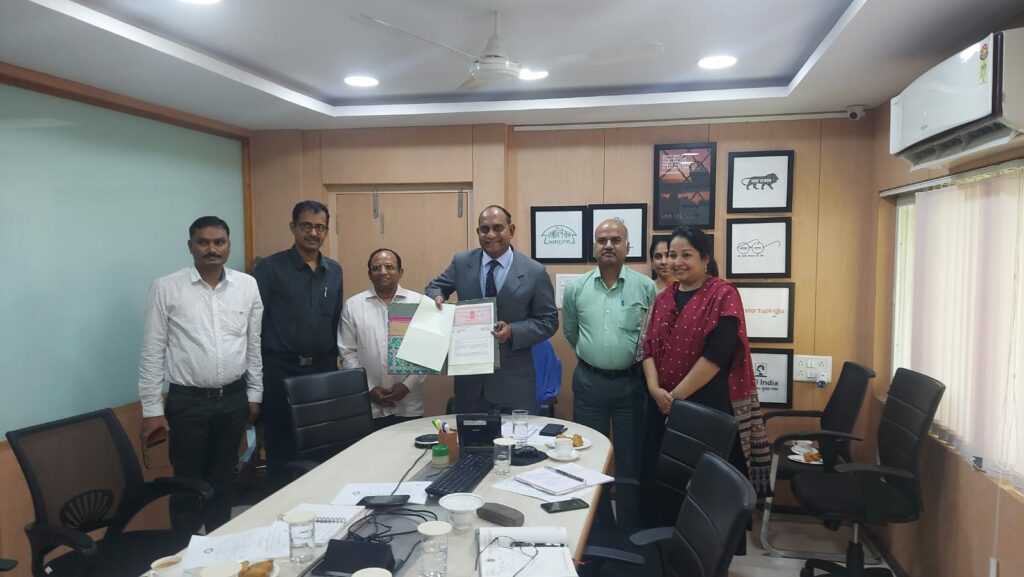
The MoU will contribute to strengthening the capacity and skills of Panchayati Raj Functionaries on health, policy support, capacity building of PRIs, research and documentation.
The successful collaboration serves as the first step towards a long and collaborative partnership in building healthy communities. Both organisations have identified the areas of common interest for cooperation in policy support, capacity building training for PRI functionaries, research and best practices. The key areas identified under this partnership specifically relate to policy support, capacity building of PRI functionaries, research and documentation.
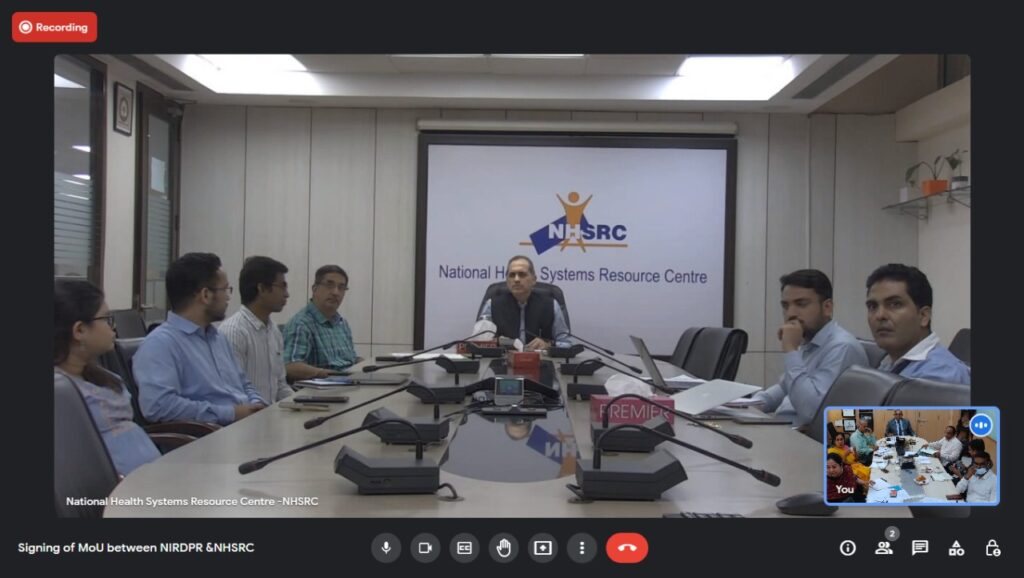
The MoU was signed by Brig. Sanjay Baweja, Principal Administrative Officer NHSRC and Dr. M. Srikanth, Registrar and Director (Admin), NIRDPR, in the presence of the Director General, NIRDPR. Shri Shashi Bhushan, ICAS, Deputy Director General, NIRDPR, Dr. Jyothis Sathyapalan, Professor & Head, CPGS&DE and CDC, Dr. Radhika Rani, Director, NRLM Cell, Dr. Digambar A. Chimankar, Associate Professor, CWEL and Dr. Sucharita Pujari, Assistant Professor, CWEL were also present at the event. The NHSRC officials also attended the ceremony via videoconferencing.
Maj Gen (Prof.) Atul Kotwal, Executive Director, NHSRC expressed delight over the signing of MoU. Stressing the need to effectively utilise 15th Finance Commission grants by the PRIs, he wanted it to be taken up on priority.
Speaking on this occasion, Dr. G. Narendra Kumar, IAS, Director General, NIRDPR highlighted the timely execution of this MoU in the wake of the COVID-19 pandemic.
The DG emphasised on increasing awareness among grassroots-level functionaries and convergence of various Government of India programmes and State-specific schemes, such as the National Health Mission, to ensure that healthcare initiatives in rural areas are well grounded. He urged to look at health interventions from the perspective of poverty alleviation, with a focus on improving the quality of life in rural areas.
“High healthcare expense is the second-most predominant cause for people slipping into poverty. Though there is a need for affordable healthcare services in rural areas, the PRIs lack the capability. Developing those capacities is a challenging task. Panchayats should be enabled to develop a village health plan by the convergence of schemes and fund flow streams”” Dr G. Narendra Kumar said.
Stating that the main motto of NIRDPR is poverty alleviation and improving the quality of life in rural India, the DG observed that out-of-pocket expenses on healthcare are one of the major causes of poverty in rural India.““In this context, developing the capacity, knowledge and skills of PRIs on different utilisation of health schemes, enabling them to develop a village health plan and monitoring strengthening of the health systems are crucial to improve the quality of life of rural communities”” he said.
Shri Shashi Bhushan, Deputy Director General, NIRDPR earlier welcomed the officials and emphasised the need to work on the localisation of Sustainable Development Goals and targets for developing a healthy village. On the occasion, both sides discussed the possibilities of expanding cooperation for research on public health through the medium of academic programmes.
NIRDPR Celebrates Mahatma Gandhi’s 153rd Birth Anniversary
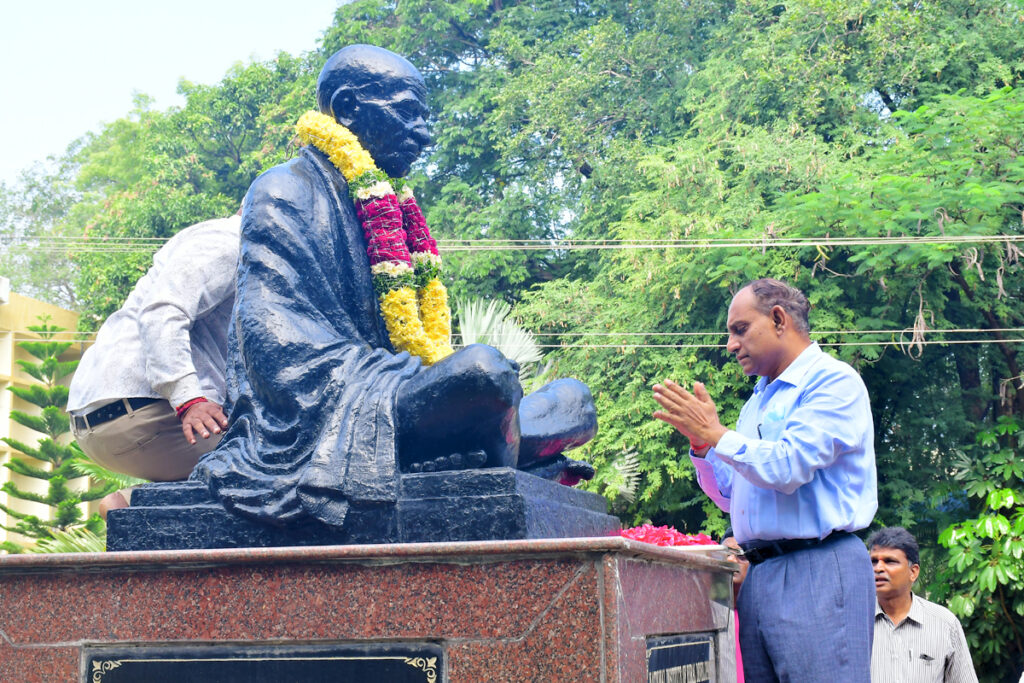
The National Institute of Rural Development and Panchayati Raj (NIRDPR), Hyderabad observed the 153rd birth anniversary of Shri Mohandas Karamchand Gandhi, the Father of the Nation, on 2nd October, 2022. Dr. G. Narendra Kumar, IAS, Director General, NIRDPR, Dr. M. Srikanth, Registrar & Director (Admin), NIRDPR and faculty, non-academic staff and students took part in the celebrations.
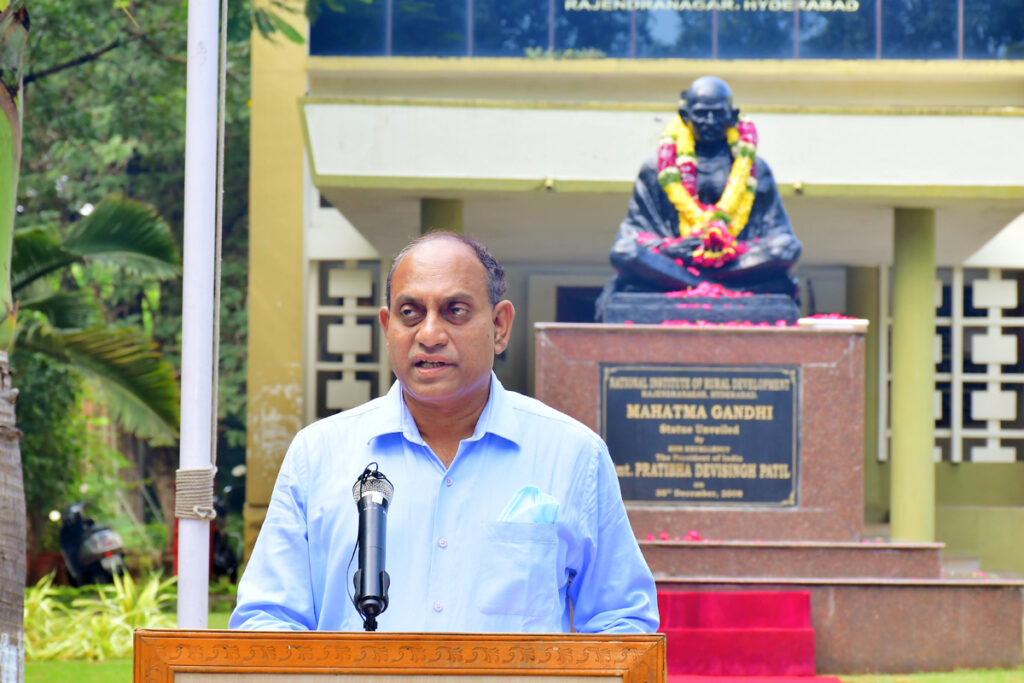
The Director General garlanded the Gandhi Statue in front of the Mahatma Gandhi block. Following him, faculty members and staff offered floral tributes. The DG addressed the gathering and also administered the Swachhata pledge on the occasion.
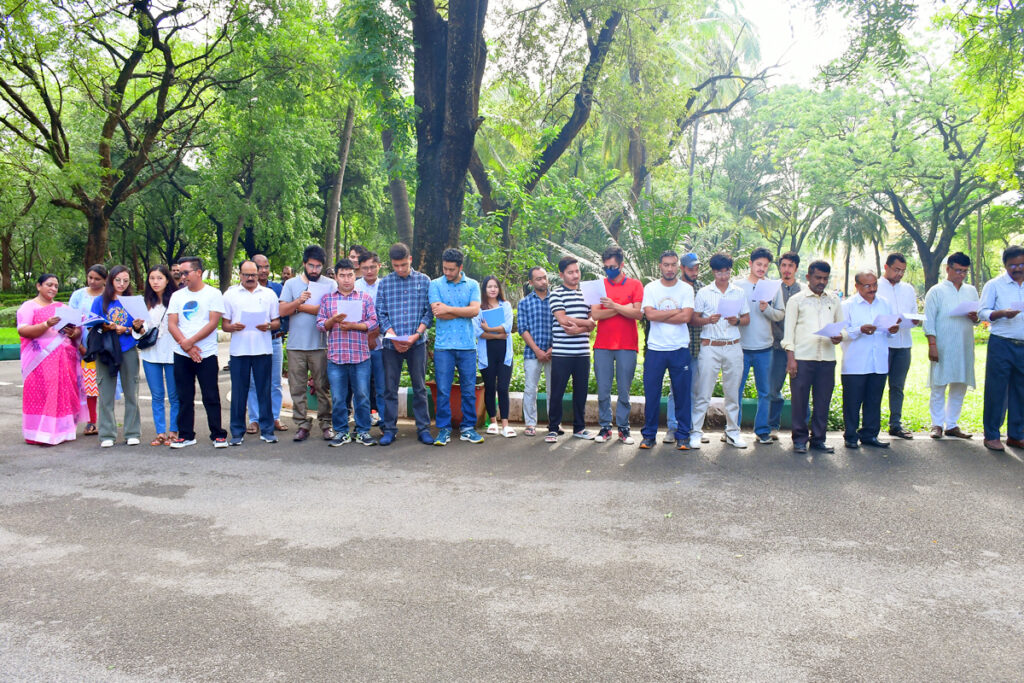
The video link of the 153rd Gandhi Jayanti celebrations at NIRDPR is provided below:
ToT Programme on TMS and SECURE for Estimation of MGNREGS Works
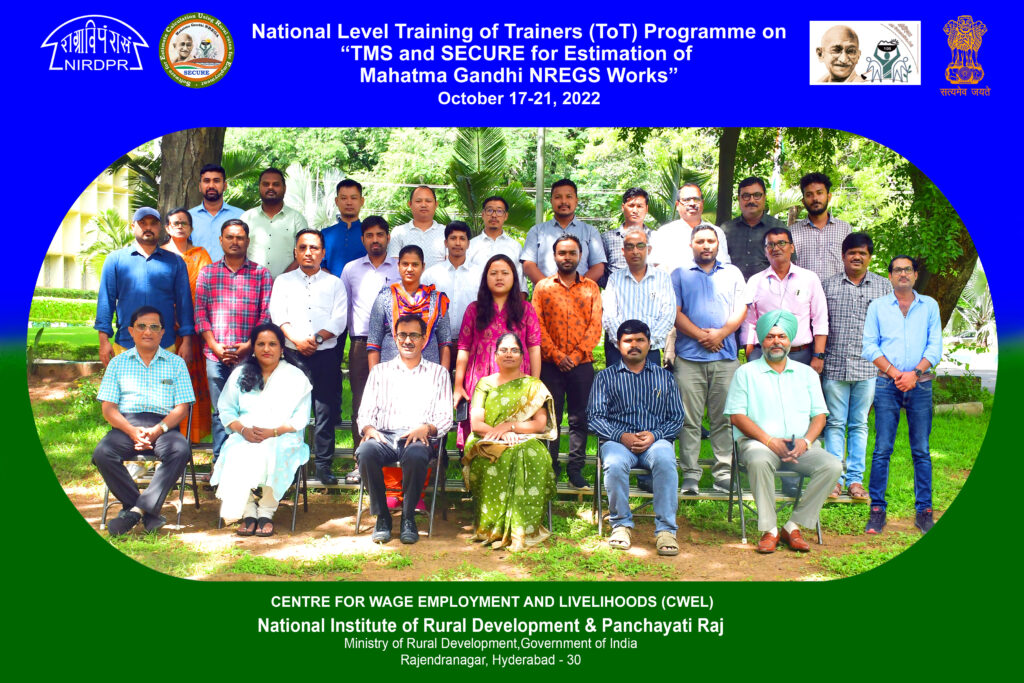
The Centre for Wage Employment and Livelihoods (CWE&L), NIRDPR organised a national level Training of Trainers (ToT) programme on TMS and SECURE for estimation of Mahatma Gandhi NREGS Works at NIRDPR, during 17th – 21st October, 2022. Altogether, 24 participants from various States, namely Arunachal Pradesh, Chhattisgarh, Jharkhand, Maharashtra, Mizoram, Nagaland, Odisha, Punjab and Telangana, attended the programme. The participants were senior and middle-level officials associated with Mahatma Gandhi NREGS at the State, district and block levels.
The objectives of the ToT programme were i) improving the capacity of engineers primarily on the basics of Mahatma Gandhi NREGS guidelines, ii) imparting the basics of Time and Motion Study and methodological guidelines, iii) imparting a basic understanding of the process of estimation of Mahatma Gandhi NREGS works using SECURE software,participants’ncing participants’ familiarity with the rural standard schedule of rates.
The methodology adopted included technical sessions by faculty members of NIRDPR and NIC experts from Kerala, case presentations, video film-based discussions and hands-on exercises using the DEMO software application.
The course was inaugurated by Dr. C. Dheeraja, Head, CWE&L, and she discussed the importance of training in SECURE in estimating the Mahatma Gandhi NREGS works. The course design was briefly presented by Dr. Raj Kumar Pammi, Course Director and Assistant Professor, CWE&L.
Prof. Jyothis Sathyapalan, Head, CDC and CPGS&DE made his opening remarks based on the Time and Motion Study under Mahatma Gandhi NREGS and highlighted the dynamics and challenges of collecting field data during the pre and post-monsoon seasons. The faculty members of CWE&L, NIRDPR and resource persons Ms. Susy. M, Scientist (E) and Shri Athul. R.D Programme Officer, NIC, Kerala discussed and presented the technical sessions.
In the valedictory session, the participants said that the session helped in upgrading their knowledge, skills in the area of SECURE application and various chapters such as Estimate Creation & Approval, DATA, Rates, Recalculation –Unskilled & LMR, Spill Over Estimate Creation and Approval, Creation of Model Template, Revision of Estimates-Previous & Current Year, M-Book and Convergence. Further, they said they would organise similar training programmes at district and block levels. They also appreciated the knowledge and skills of faculty members of NIRDPR and NIC-Kerala.
The programme was coordinated by Dr. Raj Kumar Pammi and Dr. P. Anuradha, Assistant Professors, CWE&L.
A similar 5-day Training of Trainers programme on TMS (Time and Motion Study) and SECURE (Software for Estimate Calculation Using Rural Rates for Employment) was conducted during 12th -16th September, 2022. A total of 23 Officials (Civil Engineers dealing with SECURE) from 10 States underwent the ToT programme. The participants belonged to the States of Andhra Pradesh, Bihar, Gujarat, Himachal Pradesh, Karnataka, Meghalaya, Punjab, Telangana, Tripura, and West Bengal.
Training Methods and Techniques for Faculty of Rural Development Institutes
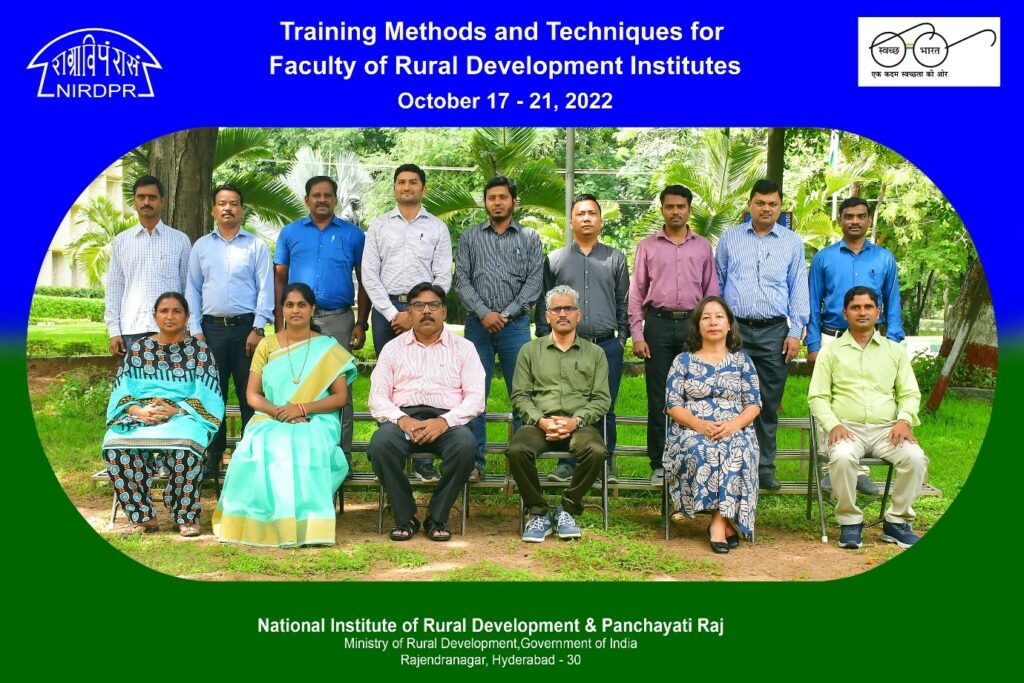
The Centre for Human Resource Development, National Institute of Rural Development and Panchayati Raj, Hyderabad organised a tra‘ning programme on ‘Training Methods and Techniques for Faculty of Rural Dev’lopment Institutes’ at the Institute during 17th -21st October, 2022. Thirteen faculty members from SIRDs/ETCs from the States of Andhra Pradesh, Maharashtra, Mizoram, Uttar Pradesh and Telangana attended this programme.
Dr. Lakhan Singh, Assistant Professor, Centre for Human Resource Development, designed and organised this programme. The objective of this programme was to equip the participants to develop skills in training methods, presentation skills and soft skills in order to make the training programmes more effective.
To enrich the knowledge and skills of the faculty members, eminent academicians and experts in the relevant fields from reputed training institutes were invited to deliver lectures on important topics such as presenting skills & techniques, lecture method – communication skills, role-play method, buzz method, panel discussion & symposium, demonstration & de-briefing, computer applications & animations in training, use of the online platform for evaluation of training programmes, soft skills and qualities of an effective transfer assignment, designing a training programme: principles, trends in training and capacity development approaches, action plan for follow-up, etc.
Some useful exercises were assigned to faculty members to upgrade their abilities and thinking process. The participants were taken to Rural Technology Park (RInstitute’s on the Institute’s premises, where rural technology-based low-cost housings, units on home needs, small and village enterprises, solar energy, etc, are exhibited.
At the end of the programme, the participants were asked to evaluate the course on a five-point formula, and the programme was rated as Excellent. All the participants indicated an improvement in their knowledge and skills after undergoing this training, particularly in designing and conducting the training programmes in a much more effective manner. They recommended continuation of this programme for the benefit of the faculty of rural development institutes.
Orientation Workshop on Financial Inclusion for Bankers at Uttarakhand SRLM
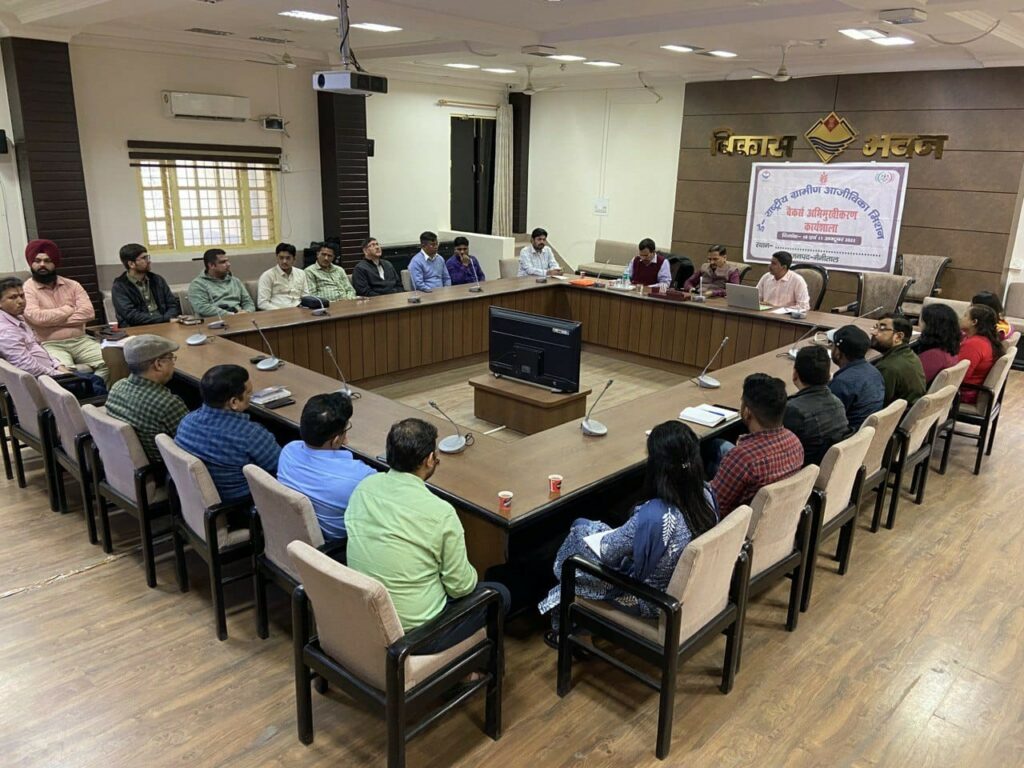
In order to achieve the goal of Deen Dayal Antyodaya Yojana-National Rural Livelihoods Mission, which is providing sustainable livelihood opportunities to the poorest of the poor through a multi-dimensional approach and enabling them to access easy and affordable financial services, the National Rural Livelihoods Mission Regional Centre – National Institute of Rural Development and Panchayati Raj (NRLMRC- NIRDPR), with the support of Uttarakhand State Rural Livelihood Management (USRLM), cobankers’a series of 18 bankers’ orientation workshops on SHG bank linkages under FinanciBankers’sion vertical.
Bankers’ orientation workshops were organised in all 13 districts from 10th October to 18th October 2022. A total of three teams of National Resource Persons (NRPs) successfully conducted the 18 workshops in close coordination with Mission Manager, Financial Inclusion (FI), NRLMRC and Young Professional, USRLM.
NRLMRC-NIRDPR has developed a one-day session plan andbankers’e material for bankers’ orientation workshop on financial inclusion in consultation with Financial Inclusion experts from the National Mission Management Unit, Ministry of Rural Development and NIRDPR, which was approved by the Technical Quality Improvement and Management committee. The session plan comprises four sessions:
Session 01 – Overview of NRLM and insights into NRLM financial inclusion
Session 02– SHG saving and credit bank linkages, uniform interest subvention, CBRM, role of Bank Sakhi and OD limit to SHG Members in Pradhan Mantri Jan Dhan Yojana (PMJDY) accounts
Session 03– Overview of online loan application portal, Jansamarth portal and NRLM bank linkage portal
Session 04– Overview of financial literacy concept in NRLM, insurance and pensions, digital finance (BC Sakhi & Dual Authentication Process), and enterprise finance to women-led enterprises.
All workshops were attended by bankers of PSUs, RRBs, Cooperative Banks & Private banks, NRLM district/ block Staff and cadres – Bank Sakhis/Digipay Sakhis.
The major observations are as follows:
- More than 200 Bank Sakhis were identified and trained but not deputed in banks. In all the batches, bank managers requested deputing Bank Sakhis to their branches at the earliest.
- All SHG loan applications (100 per cent) are processed through the online loan application portal. In this regard, the district/block staff have noted that the data pertaining to change of SHG members were updated on the MIS portal, but the same was not reflected in the online loan application portal. Due to this issue, the status of several applications is shown as pending.
- Roll out of BC Sakhi & dual authentication process needs to be initiated/accelerated
- A huge gap between sanctioning of loans on the online portal and its disbursement was observed, and it points to the need for regular follow-ups with bank officials.
NIRDPR Wellness Committee Organises Blood Donation Camp
The Wellness Committee of the National Institute of Rural Development and Panchayati Raj, Hyderabad organised a blood donation camp on 12th October, 20Nizam’sssociation with Nizam’s Institute of Medical Sciences (NIMS), Hyderabad. The programme was inaugurated by Shri Shashi Bhushan, Deputy Director General (i/c), NIRDPR in the presence of the NIMS medical team members, NIRDPR faculty, staff and students.
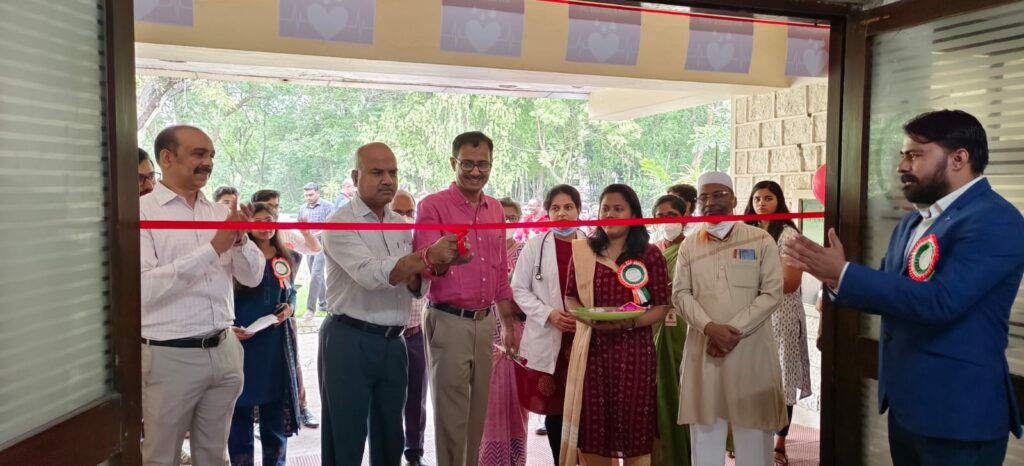
The first unit was donated by Shri Shashi Bhushan to motivate the students, staff and others to come forwa‘d to take pMahadaan’e ‘Raktdaan – Mahadaan’ programme. A total of 50+ units of blood were donated to the cause.
Stating that the blood donation programme would b made an annual event, the Wellness Committee said they are planning many such activities in the near future.
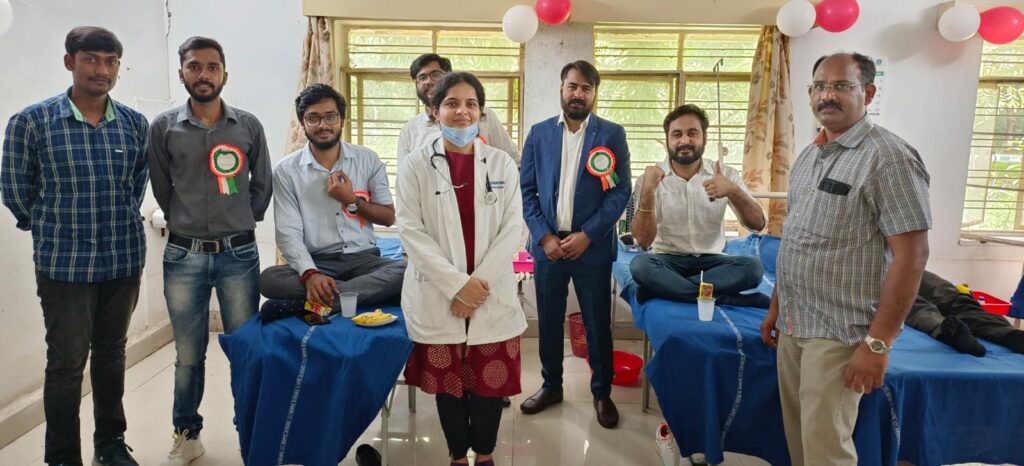
Apart from the Wellness Committee members, Dr. Jyothis Sathyapalan, Prof. & Head, CDC and CPGS-DE, Dr. Sarah Mathews, Lady Medical Officer, Dr. A. Debapriya, Associate Prof., CPGS&DE, Dr. Satya Ranjan Mahakul, Assistant Prof., CESD, Dr. Madhavi of NIMS and employees from DDU-GKY took part in the event.
ToT Programme on Value Chain & Business Development Plan-Level-II under Non-Farm Livelihoods
The Self-Help Groups (SHGs) have emerged as crucial stakeholders in the rural livelihood landscape. During the pandemic and the subsequent lockdown period, the SHG-based non-farm livelihood avenues and women-owned enterprises not only come up as social safety net for poor families but also contributed significantly to reviving the rural economy. To put SHGs on a scale ladder and convert them into a productive business entity, a series of schemes and programmes have been implemented under NRLM.
Linking SHGs with formal institutions and markets will be crucial to put these SHGs on a graduation path. However, it has been witnessed that SHGs are not only lacking the required skills to develop an effective business plan but also unable to exploit their full potential to take part and gain from the value chain. Many SHGs are also unaware of the schemes and programmes meant for them. Regular and continuous training and capacity development of various functionaries of NRLM and SRLM is a crucial ingredient for transforming SHGs into productive enterprises. Keeping these objectives in mind, the NRLM RC, in collaboration with CEDFI, has rolled out a series of curated and customised training programmes, addressing the specific needs of various categories and levels of functionaries associated with non-farm livelihood initiatives. In continuation to the ToT conducted from 30th August – 02nd September, 2022, a higher order ToT programme on ‘Value Chain & Business Development Plan-Level-II’ under Non-Farm Livelihoods’ was completed during 18th – 21st October 2022.
A total of 16 participants from seven States, namely Andhra Pradesh, Kerala, Maharashtra, Odisha, Tamil Nadu, Telangana and West Bengal, participated in this programme. These participants were working at block, district and State levels in SRLMs. On the first day, Dr. Ch. Radhika Rani, Director, NRLM-RC welcomed the participants and apprised them about various training initiatives undertaken by NRLM –RC. Dr. P. P. Sahu, Associate Professor, CEDFI discussed in detail the schedule and key objectives of this training programme.
A full session was spent to understand the needs and expectations of these participants. Pre and post-tests were also conducted to assess the impacts of this training programme on the learning outcomes of these participants. The results of the pre and post-tests conducted are as follows:
| Index | In Pre-test | In Post-test |
| Total Points | 25 | 25 |
| Total Respondents | 16 | 15 |
| Points range | 11-24 | 15-25 |
| Median | 17 | 21 |
During the four-day training, in-depth discussions were made on the following topics, such as Issues & Challenges of the rural non-farm sector, Business opportunities and identification, Designing entrepreneurial opportunities in rural areas, CRP-led enterprise promotion: A case of Deshpande Foundation, Marketing and Preparation of Marketing Plan, Book-keeping & Financial Statement, Business Finance/Enterprise Finance, Packaging and Various Techniques for Safer Storage and Marketing of Products (produced and marketed by SHGs or rural small enterprises, Collectivisation: the role and potential of FPOs, and the process of enterprise tracking and monitoring and format of Performance Tracking Record. Further, in a special session, representatives from NMMU discussed the future action plan for the next five years, as envisaged by the Ministry under the non-farm livelihoods.
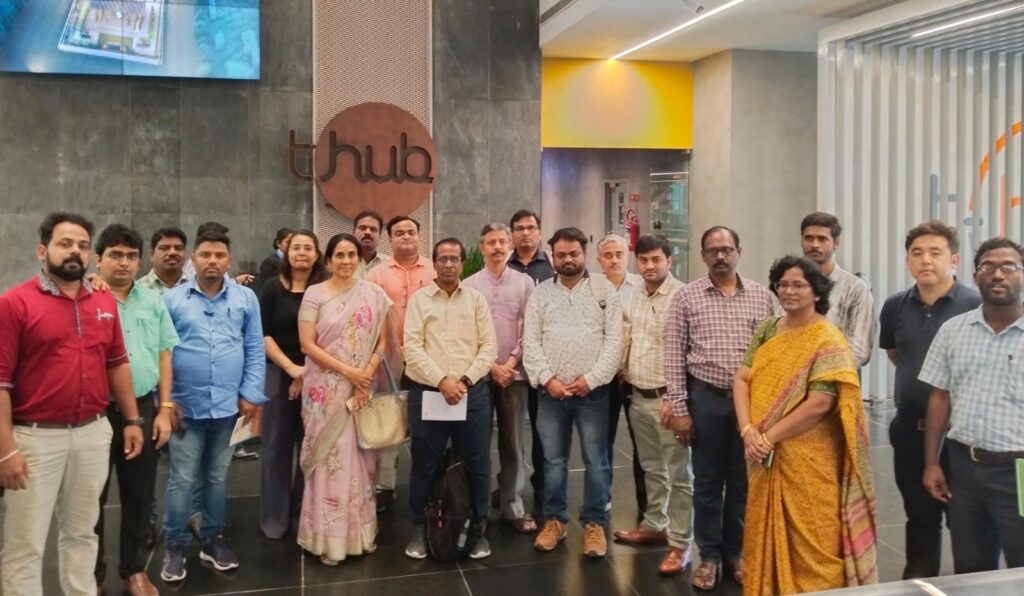
Many SRLMs are undertaking unique initiatives towards inclusive and sustainable non-farm livelihood development at the State level. To learn from such efforts, the works of Odisha Livelihoods Mission (OLM) in the areas of marketing, branding and packaging, helping SHGs & PGs to market their products on digital platforms and showcasing SHG products in airports were deliberated. This session generated a lot of discussion on how some of these could be replicated in other States.
An exposure visit to the new Technology-Hub (T-Hub), Hyderabad, an emerging platform to support start-ups, was arranged for the participants. At T-Hub, the participants got to know about various facets of start-ups.
Although T-Hub focuses mainly on tech space, it is important to know how it is functioning and how lessons can be drawn to promote rural start-ups. T-Hub is facilitating all kinds of support inducing finance, incubation, handholding, networking, etc., to both aspiring and existing entrepreneurs. It is closely working with big corporates, governments, academia and investors to drive transformative changes. Its innovation ecosystem stands firmly on seven key pillars, bridging the gap between visionary entrepreneurs and corporates seeking the next big idea, and everyone in between. T-Hub also offers funding opportunities that can assist start-ups in the different stages of their entrepreneurial journey.
In order to keep the participants fully engaged, all the sessions were conducted in an interactive and participatory mode. In the last session, detailed feedback was collected from the participants through the online Training Management Portal, and they were handed over certificates. The participants also shared their experiences of the four-day training and identified areas requiring more focus. During the valedictory session, programme coordinator Dr. P. P. Sahu, CEDFI, presented a brief summary of the training programme and also appraised the future programmes. Mr. Nawin Kumar, Mission Manager and R. Murali Dhar, Mission Executive of NRLM-RC, NIRDPR coordinated the programme.
NIRDPR Organises Hindi Day Celebrations
National Institute of Rural Development and Panchayati Raj organised Hindi Fortnight from 14th – 28th September, 2022. As a part of Hindi Fortnight, Hindi Day was celebrated, and many competitions for officers and staff were conducted.
The prize distribution ceremony was organised on 19th October, 2022. The celebrations began with Ganesh Vandana. Smt. Anita Pandey, Assistant Director, Official Language, presented the outline of the programme and welcomed the guests.
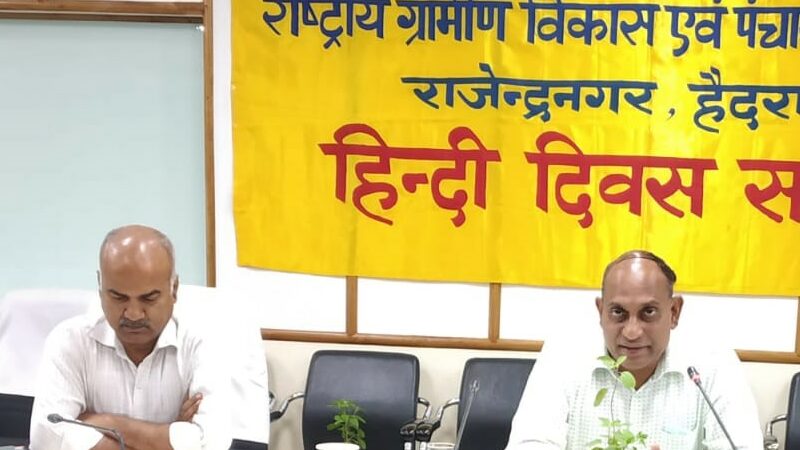
The Hindi Day celebration was presided over by Dr. G. Narendra Kumar, IAS, Director General, NIRDPR. He wished everyone present in the auditorium on the occasion of Hindi Day and congratulated the winners of the competitions organised in the institute during the Hindi Fortnight. Appreciating the officers and employees of Hindi section for organising Hindi Fortnight, he said that translation of training material is being done on a large scale in the Institute, which is a commendable work.
As part of Hindi Fortnight, calligraphy, translation, elocution, typing and essay competitions were organised in the Institute. On the occasion of the Hindi Day celebration, Shri Shashi Bhushan, ICAS, Deputy Director General, NIRDPR expressed his views and requested everyone to increase the use of Hindi in their work.
Shri E. Ramesh, Senior Hindi Translator anchored the programme and presented vote of thanks.
National Level ToT Programme on MGNREGS Financial Management: PFMS, DBT and Aadhaar Seeding
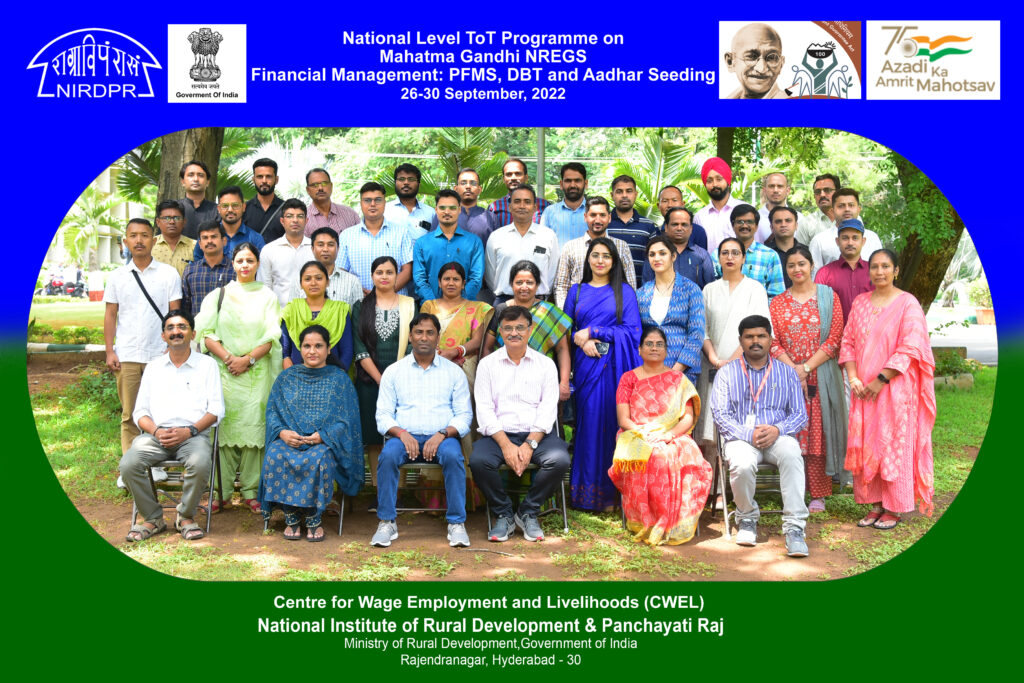
The Centre for Wage Employment and Livelihoods (CWEL), National Institute of Rural Development and Panchayati Raj organised a national-level Training of Trainers (ToT) Programme on Mahatma Gandhi NREGS Financial Management: PFMS, DBT and Aadhar Seedingat NIRDPR during 26th – 30th September, 2022. Altogether, 38 participants attended the programme from various States, namely Andhra Pradesh, Chhattisgarh, Gujarat, Jammu & Kashmir, Jharkhand, Meghalaya, Punjab, Rajasthan, Tamil Nadu, Telangana, Tripura and West Bengal. The participants were senior and middle-level officials from State, district and block levels working with MGNREGS.
The programme was inaugurated by Shri Shashi Bhushan, Deputy Director General (i/c), NIRDPR and Dr. C. Dheeraja, Head, Associate Prof., CWEL. The course design was briefly presented by Dr. Raj Kumar Pammi, Course Director and Assistant Professor, CWEL. Shri Sanjay Kumar Pandey, Head, NIC and Shri Rajeev, Technical Resource Person from the National Informatics Centre (NIC), Department of Rural Development, Ministry of Rural Development (MoRD), attended the course as resource persons to deliver the technical sessions. The faculty members of CWEL, NIRDPR and resource persons from NIC, New Delhi conducted the training sessions.
The objectives of the training programme included imparting a basic understanding of PFMS, DBT and Aadhaar seeding for effective implementation of Mahatma Gandhi NREGS, introducing methods of Mahatma Gandhi NREGS Financial Management for effective implementation, and enhancing capacity and sensitising participants working for Mahatma Gandhi NREGS towards financial management.
The methodology adopted included technical sessions by faculty members and experts, case study presentations, group exercises/discussions, in-house and online interactive sessions with NIC-New Delhi/Ministry/MoRD officials, hands-on exercises/sessions, and pre and post-training assessments.
In the valedictory session, the participants opined that the training programme improved their knowledge, skills and attitudes in the area of NeFMS, PFMS, NREGA-Soft, DBT and Aadhaar Seeding, and added that they would organise training programmes at district and block levels in the back-home situation.
The programme was coordinated by Dr. Raj Kumar Pammi and Dr. P. Anuradha, Assistant Professors, Centre Wage Employment and Livelihoods (CWEL), NIRDPR.
Communication Research Unit, NIRDPR Releases Posters on Handwashing Campaign
The Communication Research Unit of NIRDPR has released a set of posters on the handwashing campaign as part of Global Handwashing Day. Every year, Global Handwashing Day is obeserved on October 15 with the objective of increasing awareness and understanding about the importance of handwashing with soap as an effective and affordable way to prevent diseases and save lives.
